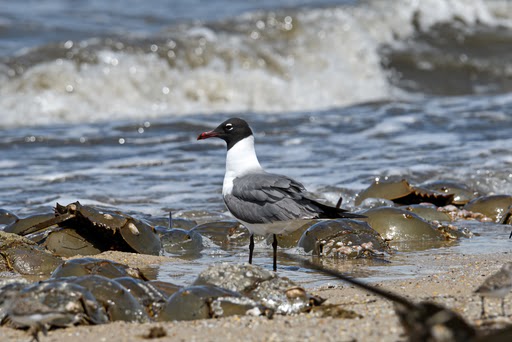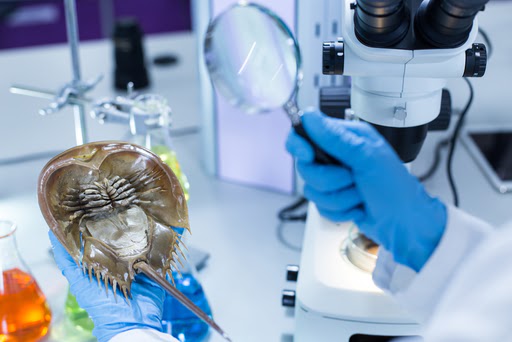Horseshoe crabs are a group of ancient organisms known as “living fossils”. They are marine arthropods and belong to the Merostomata class, which means their legs are attached to their mouths. Horseshoe crabs play a crucial role in the ecosystem as their blood contains an enzyme used in certain diagnostic tests.
When we hear the term “prehistoric creatures,” we often think of dinosaurs that roamed the Earth millions of years ago. However, there are species that existed long before dinosaurs and have survived to this day.
For example, horseshoe crabs have been scuttling along beaches and swimming in deep waters for over 450 million years. That is 100 million years before dinosaurs even appeared! What’s even more remarkable is that while dinosaurs went extinct, horseshoe crabs have managed to survive well into the 21st century.
What Are Horseshoe Crabs And Where Can They Be Found?
Horseshoe crabs are an ancient group of organisms known as “living fossils”. They are marine arthropods and belong to the Merostomata class, which means their legs are attached to their mouths.
 Four different species of horseshoe crabs: Picture 1- American horseshoe crab, Picture 2 – Tri-spine horseshoe crab, Picture 3- coastal horseshoe crab, and Picture 4- the mangrove horseshoe crab (Photo Credit : Shutterstock & Wikimedia Commons))
Four different species of horseshoe crabs: Picture 1- American horseshoe crab, Picture 2 – Tri-spine horseshoe crab, Picture 3- coastal horseshoe crab, and Picture 4- the mangrove horseshoe crab (Photo Credit : Shutterstock & Wikimedia Commons))
Contrary to their name, horseshoe crabs are not actually crabs. They are closely related to trilobites, which existed 544 million years ago, as well as spiders and scorpions.
There are four species of horseshoe crabs found on Earth.
While one species, the American horseshoe crab (Limulus polyphemus), is found in North and Central America, the other three, Tri-spine horseshoe crab (Tachypleus tridentatus), coastal horseshoe crab (Tachypleus gigas), and mangrove horseshoe crab (Carcinoscorpius rotundica) are found in the Indo-Pacific oceans.
These organisms can be found in various habitats depending on their life stage. For example, eggs are laid on beaches, juveniles inhabit sandy ocean floors, and adults can be found in deeper waters.
How Have They Managed to Survive for So Long?
Horseshoe crabs have survived three major extinction events that wiped out numerous species in the past. Three adaptations have helped these species survive. Firstly, their ability to feed on any organic matter allows them to thrive in diverse environments. Secondly, they can tolerate habitats with fluctuating salinity levels, enabling them to adapt to changing conditions caused by climate change. Thirdly, they can survive in low oxygen conditions, which are usually fatal for other marine organisms. Additionally, their blood offers protection by coagulating when they encounter bacteria.
What Do Horseshoe Crabs Look Like?
Female horseshoe crabs can grow up to 19 inches (48 cm) and are larger than males, which typically reach about 15 inches (38 cm) in size. Due to this noticeable difference in size, it is easy to distinguish between the sexes, especially during the spawning season when both are present.
Overall, the body of horseshoe crabs can be divided into three sections: the prosoma (head), opisthosoma (abdomen), and telson (tail).
The upper part of a horseshoe crab, as shown in the image, is round and U-shaped, resembling a horseshoe. The largest body part, called the prosoma, contains various important organs such as the brain, mouth, heart, glands, and nervous system. These organs are protected by a large plate. Additionally, the prosoma also houses the ten eyes of the horseshoe crab. While two of these eyes are used for finding mates, the rest serve as light receptors and help the organism detect changes in moonlight and facilitate movement. The abdomen, known as the opisthosoma, is triangular in shape and has movable spines for protection. It also contains muscles and gills, which aid in movement and breathing. Horseshoe crabs have impressive digestive organs and systems, allowing them to consume solid food. Their mouth is located in the center of the body, where the legs are attached. Although they lack teeth, they can crush food using their hind legs and then transfer it to their mouth using the rest of their legs. Unlike stingrays, the long and pointy tail of a horseshoe crab is not dangerous and is primarily used for swimming and turning over if the organism gets stuck on its back. The spawning season of horseshoe crabs varies, but it typically reaches its peak in May and June. Adult horseshoe crabs wait on the shores for females, who emit pheromones to signal their arrival. This ensures the presence of males for mating. Mating occurs when males use their special appendages to clasp onto females. Each female produces around 100,000 eggs per spawning season and lays 4-5 clutches of 4,000 eggs each time she returns to the shore. Horseshoe crabs have a lifespan of over 20 years and go through four stages in their life cycle: egg, larva, juvenile, and adult. The eggs are laid higher on the beach for warmth and hatch after two to four months. The larvae resemble miniature versions of adults but lack tails. After nearly a month, they swim into the ocean during a high tide and rest on sandy bottoms for a year. As they grow into juveniles, they move into deeper waters and feed on adult food. Over the next ten years, they molt and shed their exoskeletons to accommodate growth. After this period, they reach full adulthood.
The Importance of Horseshoe Crabs
Horseshoe crabs play a crucial role in our ecosystems.
Many shorebirds rely on their eggs as a source of food, and some even adjust their migration patterns to coincide with the crab spawning season. Additionally, smaller species like snails and mussels find shelter in their shells, while their larvae serve as a food source for various fish and invertebrates, including crabs, fish, and turtles.
Furthermore, horseshoe crabs have symbiotic relationships with other organisms. Sponges attach themselves to their shells, flatworms lay eggs on their gills and leg joints, and snails lay eggs on their backs.
 Some birds have changed their migration patterns to align with horseshoe crab spawning seasons. (Photo Credit: Michael G McKinne/Shutterstock)
Some birds have changed their migration patterns to align with horseshoe crab spawning seasons. (Photo Credit: Michael G McKinne/Shutterstock)
Despite their critical role, human activities pose a threat to all four horseshoe crab species.
Firstly, their nesting sites are being disrupted due to increased human presence on beaches, forcing them to find alternative locations to nest.
Additionally, the construction of seawalls or barriers near their nesting grounds further endangers these species.
The removal or deposition of sand, whether for construction or erosion control, also alters their nesting sites. Imported sand can affect their development due to variations in temperature and moisture content. In open waters, their populations are at risk due to mechanized trawlers and fishing nets, which can easily trap these creatures.
However, one of the most significant threats they face is from the biomedical industry. If you have ever been vaccinated or received intravenous fluids, you can thank horseshoe crabs!
When exposed to bacterial endotoxins, most of us become ill, especially when these toxins enter our bloodstream directly through injections. The blood of horseshoe crab species is used to ensure the safety of vaccines, injectable drugs, and medical equipment.
 Biomedical industries exploit horseshoe crabs for their blood. (Photo Credit: Rattiya Thongdumhyu/Shutterstock)
Biomedical industries exploit horseshoe crabs for their blood. (Photo Credit: Rattiya Thongdumhyu/Shutterstock)
How is this done?
Horseshoe crabs have an open circulatory system and rely on amoebocytes (or blood cells) for their innate immunity. Amoebocytes release a clotting agent called Limulus Amoebocyte Lysate (LAL) when bacteria or foreign substances enter the crab’s bloodstream. This agent helps clot the blood and prevent the spread of bacteria. This discovery led to the development of the “Limulus Amebocyte Lysate” test or “LAL” test.
Today, the LAL test is used to ensure the quality of biomedical drugs and medical devices. Consequently, horseshoe crabs are harvested commercially by cosmetic and biomedical companies in the United States, resulting in severe population declines.
After learning about these remarkable creatures, it is clear that horseshoe crabs deserve our utmost respect and protection!
